This post may contain affiliate links. Please read our disclosure policy.
How to make Nasi Uduk, a fragrant Indonesian coconut milk rice with pandan leaves, lemongrass, and several aromatics for a delicious Indonesian rice side dish! Cook on the stovetop, in a rice cooker, or Instant Pot for a flavorful side whenever needed!

I thought my favorite rice dish was coconut rice until I tried Nasi Uduk/Nasi Lemak. This fragrant Indonesian rice dish combines long-grain rice with coconut milk and several spices/aromatics for a truly fragrant, creamy, flavorful rice side!
The traditional cooking method wasn’t exactly simple (think cooking three ways…). However, for this modern version, I’ve included methods for a stovetop, rice cooker, and Instant Pot version of this Indonesian coconut milk rice that use a simple cook and “steam” method. Meaning the entire process takes under 40 minutes and is perfect for accompanying any mid-week meal!
For other rice basics, you might also like these posts on how to cook brown rice, perfectly fluffy jasmine rice, Lebanese rice with vermicelli, and even Thai coconut sweet sticky rice!
Want to save this recipe?
What is nasi uduk?
Nasi Uduk (“nasi” means rice and “aduk” means mixing) is a type of Indonesian rice cooked in coconut milk from the Batavia region of Indonesia. In fact, it’s extremely popular in Jakarta. There, a single portion is sold for less than $1 and is available at main roadside stalls throughout the day.
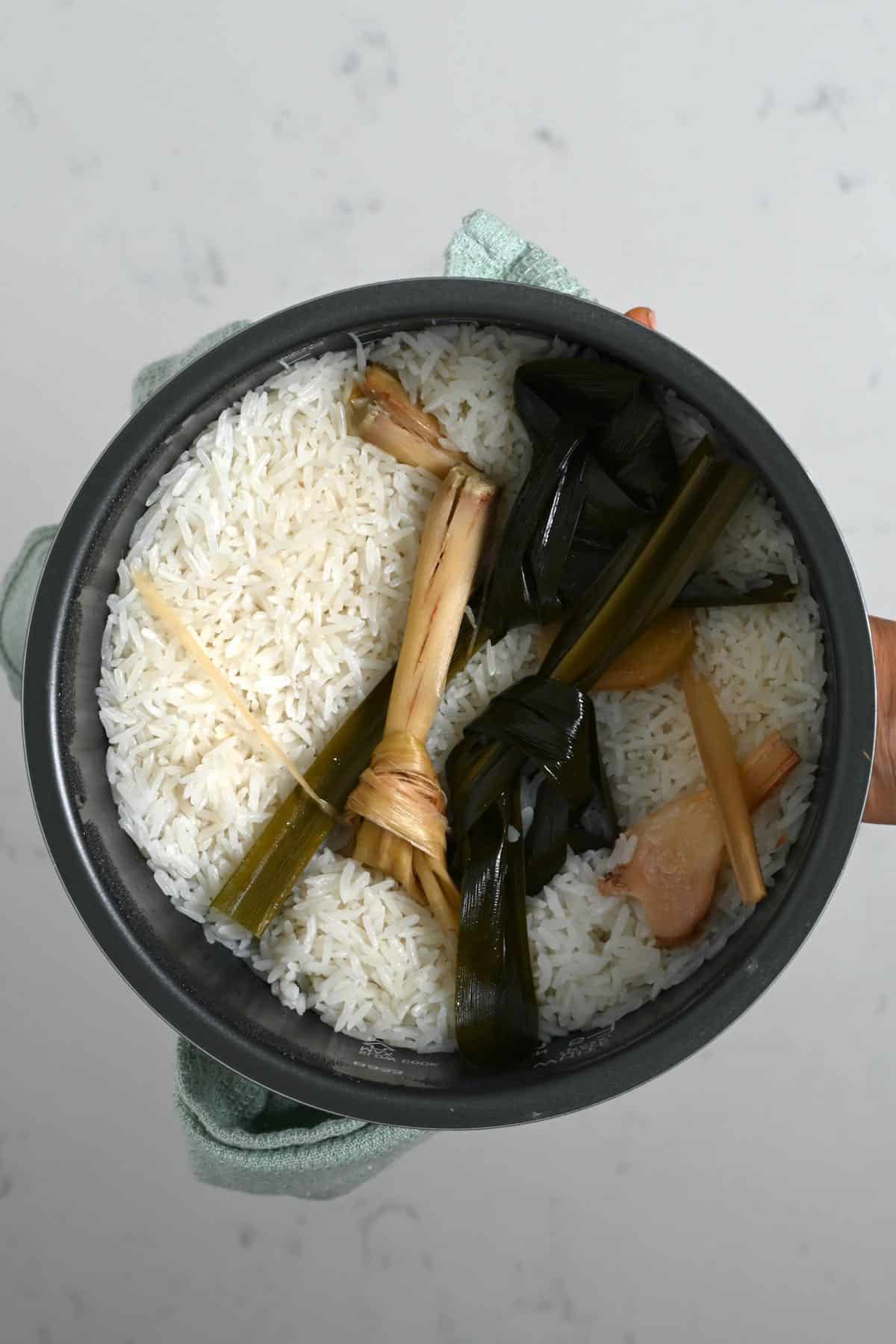
Note: Nasi Uduk is also very similar to Nasi Lemak which is considered the national dish of Malaysia. Nasi Lemak consists of fragrant rice cooked with coconut milk and pandan leaf, ginger, and a pinch of salt. However, I’ve also seen versions of nasi lemak that are almost identical to this Indonesian dish. So let me know in the comments if you know more about the differences.
Not only does this coconut milk substitute the water in the cooking process, but several aromatics are added for extra fragrance and flavor. These include lemongrass, cassia bark, cloves, and knotted pandan leaves.
Once cooked, the pandan rice is often topped with fried shallots (“bawang goreng”) and then served as a side dish with all sorts of proteins and other dishes. For example, semur (Indonesian stew), gulai (a dish with a curry sauce), sambal (chili sauce), scrambled eggs, fried tempeh/tofu, shrimp crackers, and more!
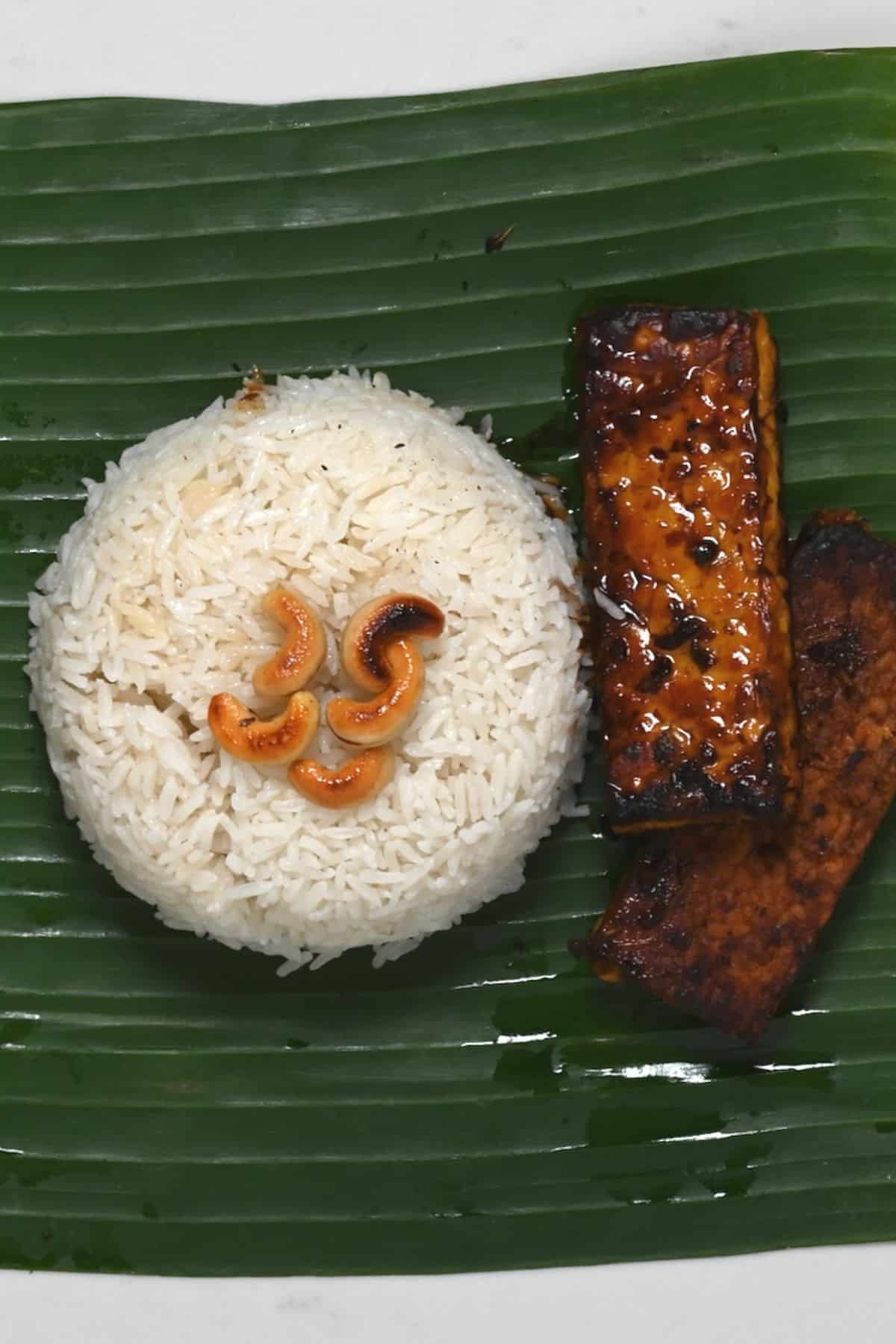
While not 100% authentic (though this dish is made slightly different from region to household anyway!), this version of nasi uduk combines the coconut milk rice (made with a bit of water) with aromatics, including lemongrass, ginger, galangal, and pandan leaves.
The combination is reminiscent of several Thai dishes I’ve previously cooked that combine similar ingredients – including Thai red curry and vegan green curry. However, for this pandan rice, they are the perfect aromatics for the ultimate fragrant rice dish! And if you like this Indonesian dish, you might also enjoy this beef rendang recipe.
The nasi uduk ingredients
- Rice: I used Jasmine rice, which is the traditional option, though any long-grain rice will work like basmati. You may be able to use long-grain brown rice, though the cooking method may vary slightly.
- Coconut milk: use tinned coconut milk – I recommend using full-fat for the creamiest results. I haven’t tried with light coconut milk.
- Pandan leaves: also called screwpine leaves. Depending on where you live, these can be tricky to find. However, they should be available in certain Asian supermarkets. If not fresh, they often sell them in frozen or dried form too.
- Aromatics: this Indonesian rice uses a combination of ginger, galangal (Thai ginger), and lemongrass as the aromatics. If you’re unable to find any of the ingredients in your local supermarket, they should be available in Asian/Thai stores.
- Salt: to season.
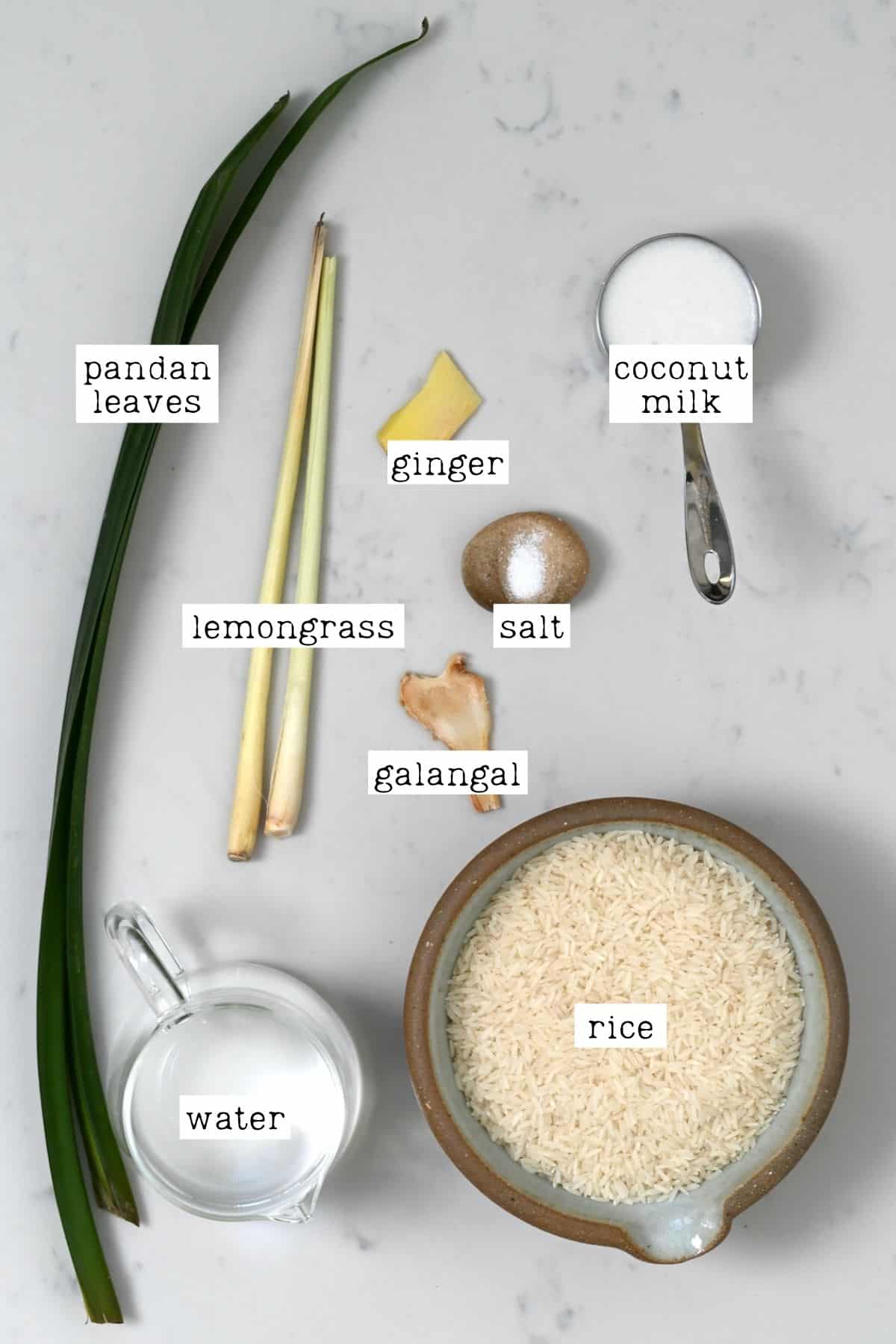
Optional add-ins
- Indonesian bay leaf (daun salam): for even more flavor, you could add 3-4 Indonesian bay leaves to the mixture. Alternatively, you could use curry leaves.
- Sugar: several versions of this Indonesian rice recipe include a pinch (or more) of sugar for a very subtle sweet aftertaste and flavor balance. I prefer it without but feel free to add a teaspoon or so to the recipe to experiment.
- Kaffir lime leaves: two kaffir lime leaves could also be added to the rice.
- Spices: cardamom, cinnamon, and cloves are all optional additions to this Indonesian rice dish, used in various restaurants and households. The amounts will vary to individual taste. I recommend adding the whole spices rather than ground (so you can pick them out afterward).
- Shallots: traditionally, nasi uduk is served topped with “bawang goreng”, which means fried shallots. To do this, finely slice the shallot/s, soak in water for 10 minutes, then dry, toss with a bit of salt and optionally cornstarch, then shallow fry until golden and crispy.
- Tumpeng Nasi Kuning – aka yellow rice, is a traditional ceremonial dish that adds turmeric powder (around 1 Tbsp for this recipe) to the rice when cooking for golden yellow rice. It is said to represent wealth/gold/abundance and is perfect for serving at parties, weddings, and other celebrations.
How to make Indonesian coconut milk rice
Step 1: Rinse the rice
First, rinse the rice well. To do this, I place it into a sieve and then in a large bowl of water. Use your hands to rub the rice with your fingers until the water is milky white. Then discard that water and replace it with new water. Repeat this 3-4 times, or until the water is almost clear.
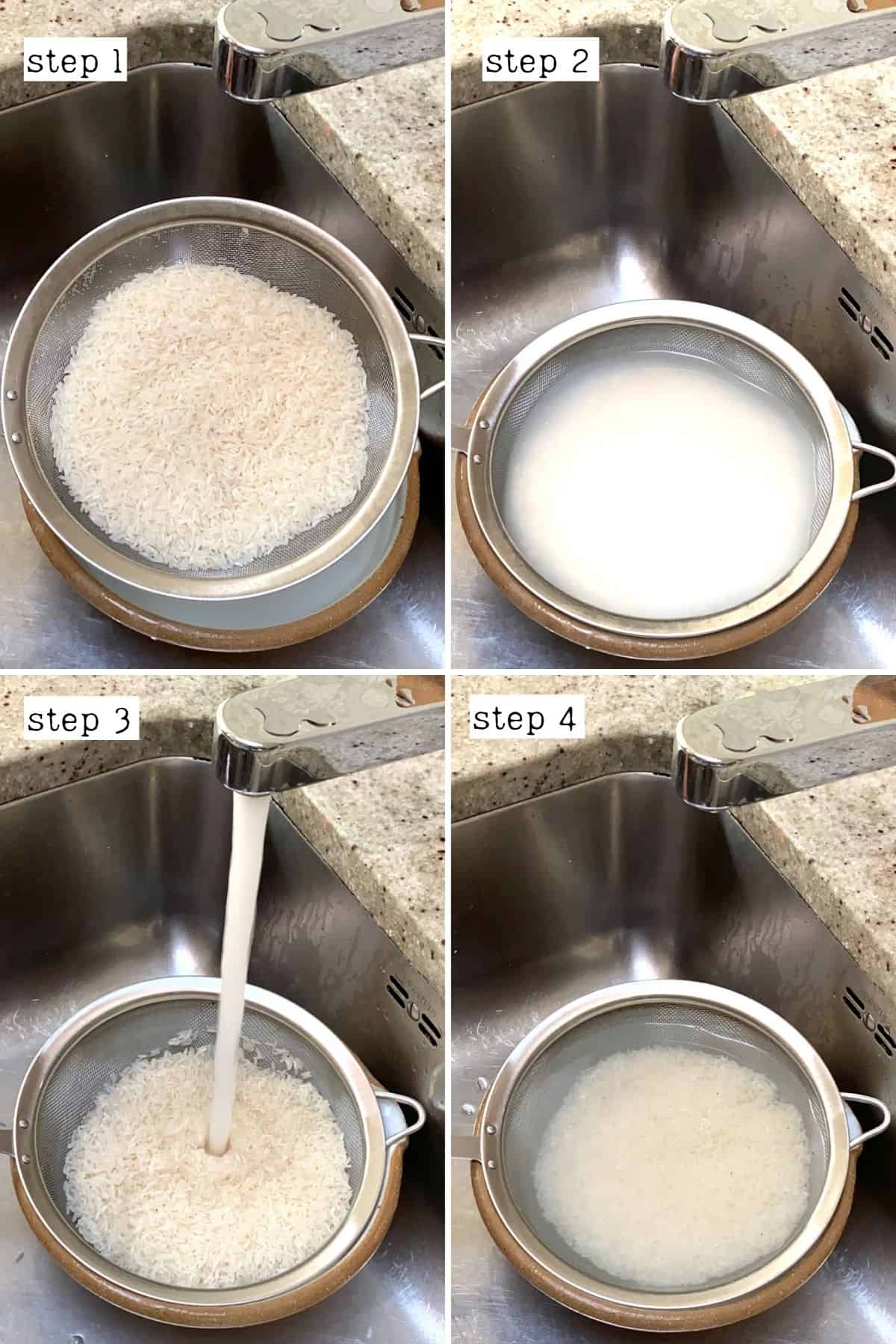
Step 2: Prepare the Aromatics
First, rinse the pandan leaves and tie them into knots. This will help them infuse their flavor into the rice more while cooking (and allows them to fit in the pot!).
Then, lightly bash the lemongrass with the side of a large knife or a rolling pin/similar tool and tie them in a knot too.
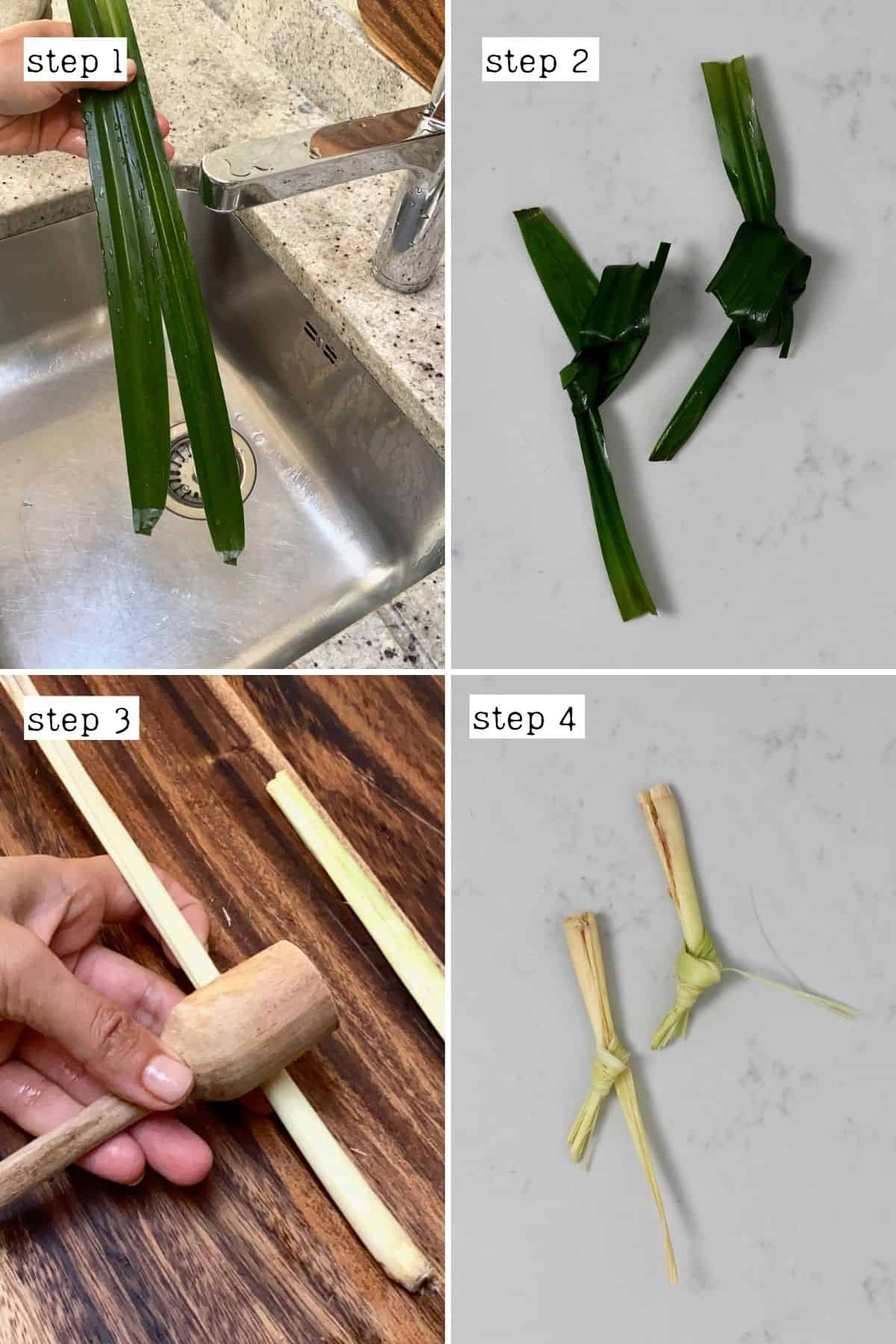
Step 3: Cook the coconut milk rice
Add all the ingredients to a saucepan and give the mixture a small stir and place its lid on.
Then, bring the mixture to a boil over medium-high heat before lowering to a simmer and cooking for 15-20 minutes. I recommend stirring it once after the first 5 minutes to reduce the risk of the coconut milk scorching at the bottom of the pan.
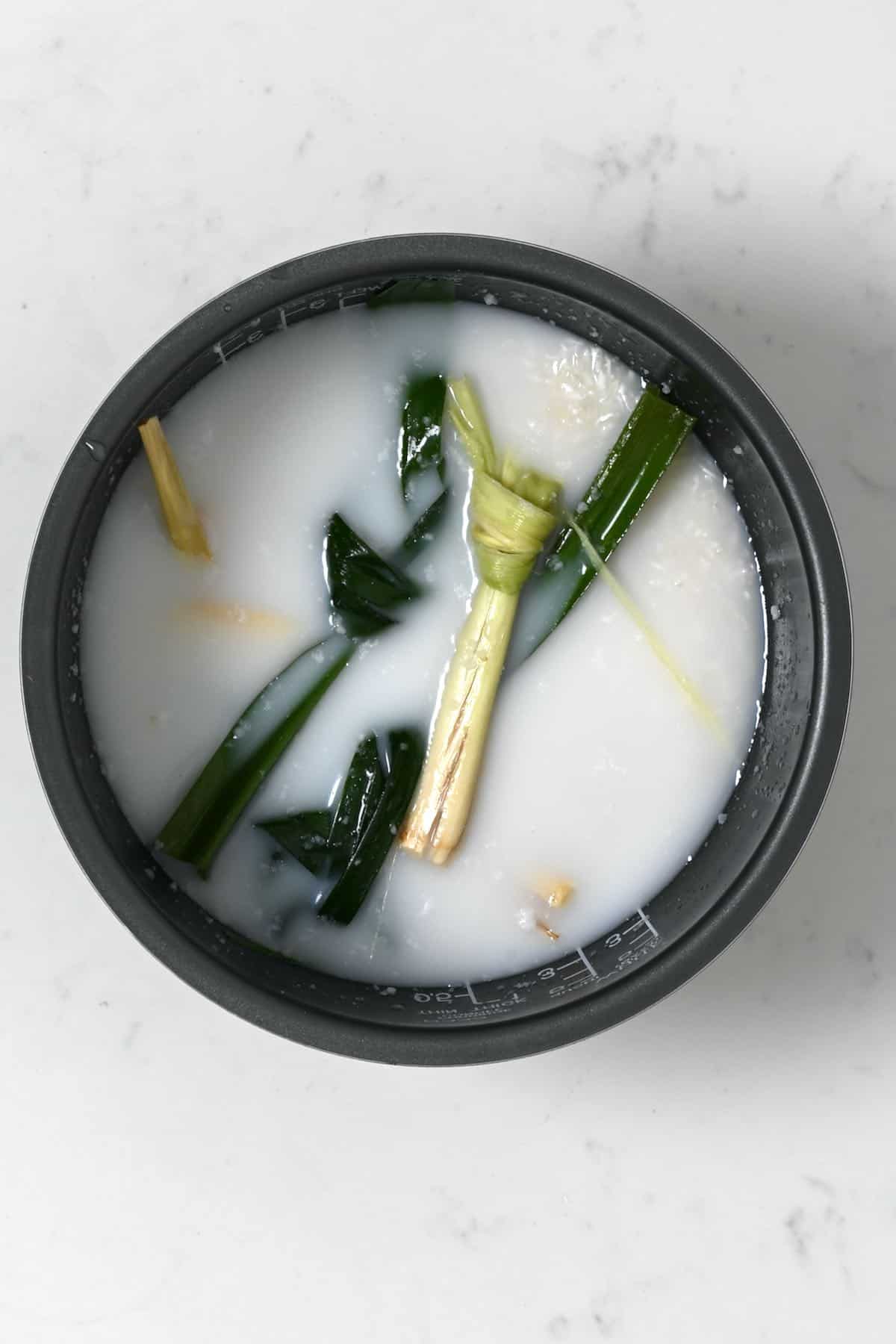
Once you notice all the liquid has been absorbed, remove the pot from the heat and allow it to stand and “steam” for a further 10 minutes before removing the lid.
You can also cook the nasi uduk in a rice cooker. Just be aware that you’ll need a little less water (check the recipe card for amounts). In a rice cooker, use the “white rice setting”. Once ready, leave to steam for a further 10 minutes before opening the cooker.
Finally, remove the lid and all the aromatics (knotted ingredients, ginger, and galangal). You can then serve it – typically, this is done as a “mound” or in a cone shape. Then enjoy with the mains and sides of your choice!
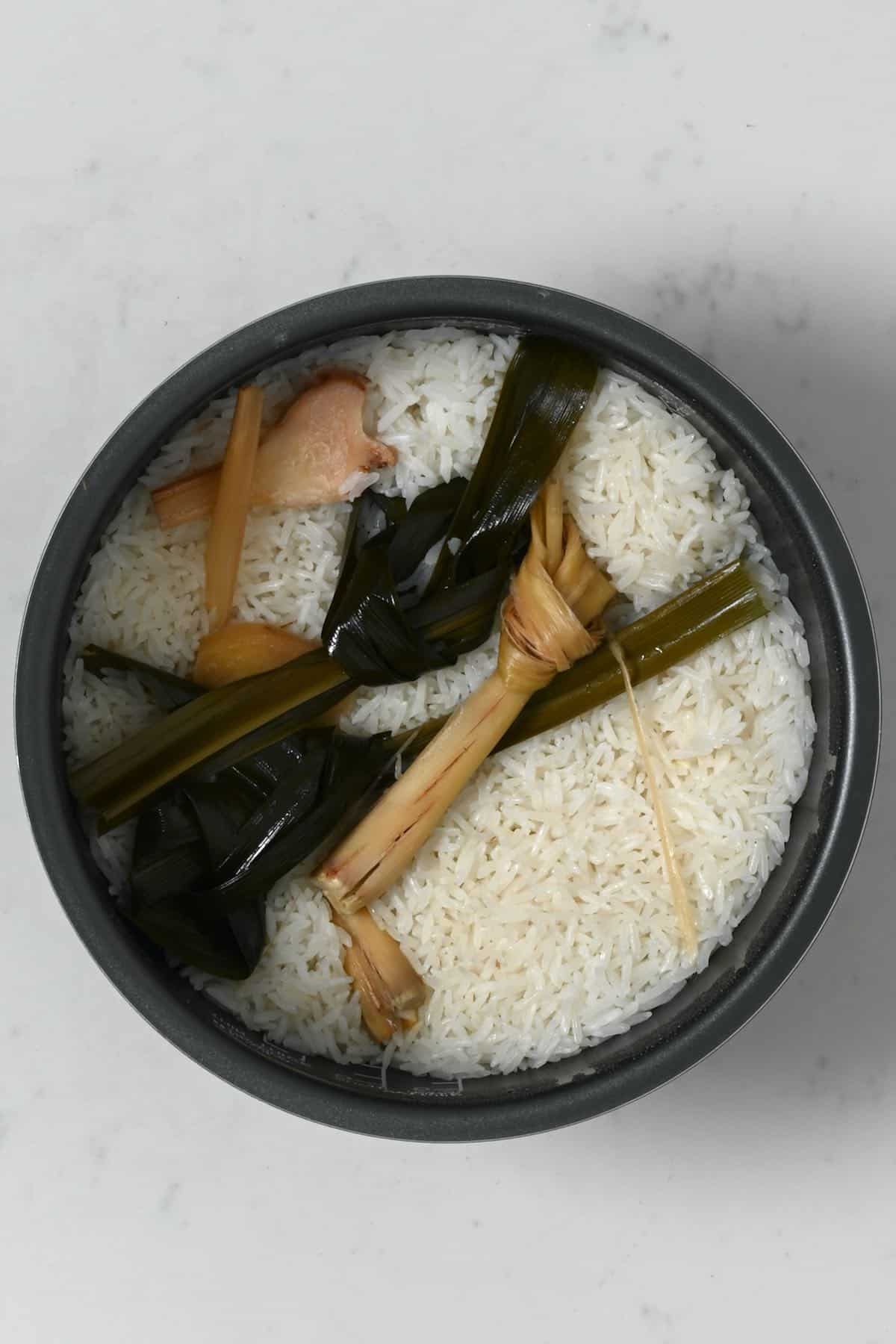
How to store
Store: you can store the leftover coconut pandan rice in an airtight container in the refrigerator for between 3-4 days.
Freeze: transfer the cooked rice to freezer-safe containers and freeze for up to 4 months. Allow to thaw in the fridge before reheating.
Reheat: as rice sits, it tends to dry out. So when reheating, make sure to splash with a bit of additional coconut milk or water, then reheat on the stovetop, in the microwave, or on the “warm” function in your rice cooker.
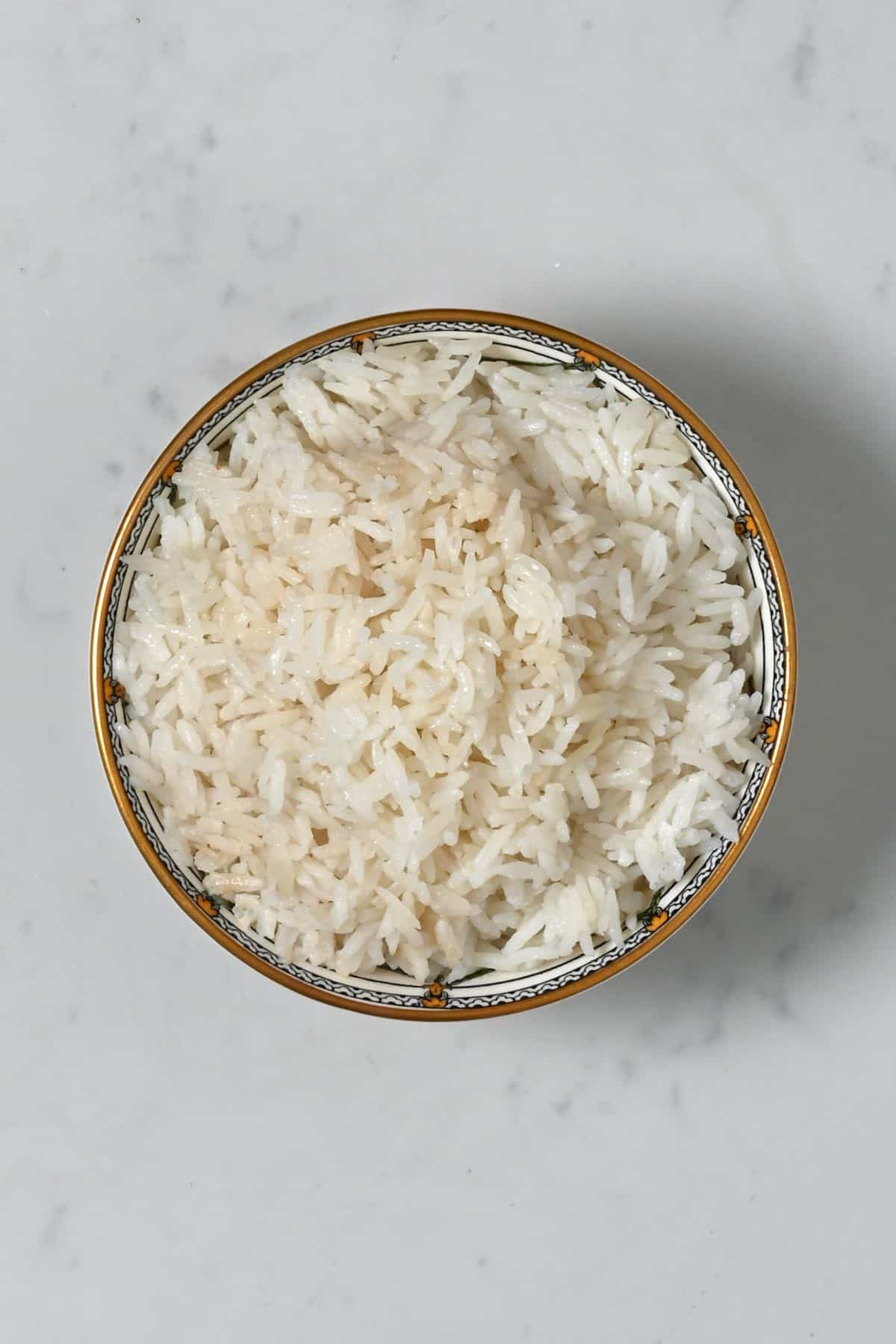
How to serve
Nasi uduk is often served in a cone shape. To do so, wrap a clean banana leaf or several sheets of aluminum foil into a cone (and secure with a toothpick or tape) and then spoon in a serving of the warm rice, pressing to pack tightly. Then transfer that to a plate and carefully de-mold.
Once on the plate, serve the rice with all kinds of dishes, particularly sambal dishes (and others mentioned at the top of the post). This time I enjoyed it with Indonesian fried tempeh and topped with lightly fried cashew nuts for a simple, flavorful meal! However, it is often served with several small sides.
A complete dish would typically include the nasi uduk rice topped with fried onions, then served alongside peanuts, shallow fried dried fish, egg (omelette or hard-boiled eggs), vermicelli noodles, sambal, and a protein like fried chicken, or vegan(try how to make tofu with super simple methods.
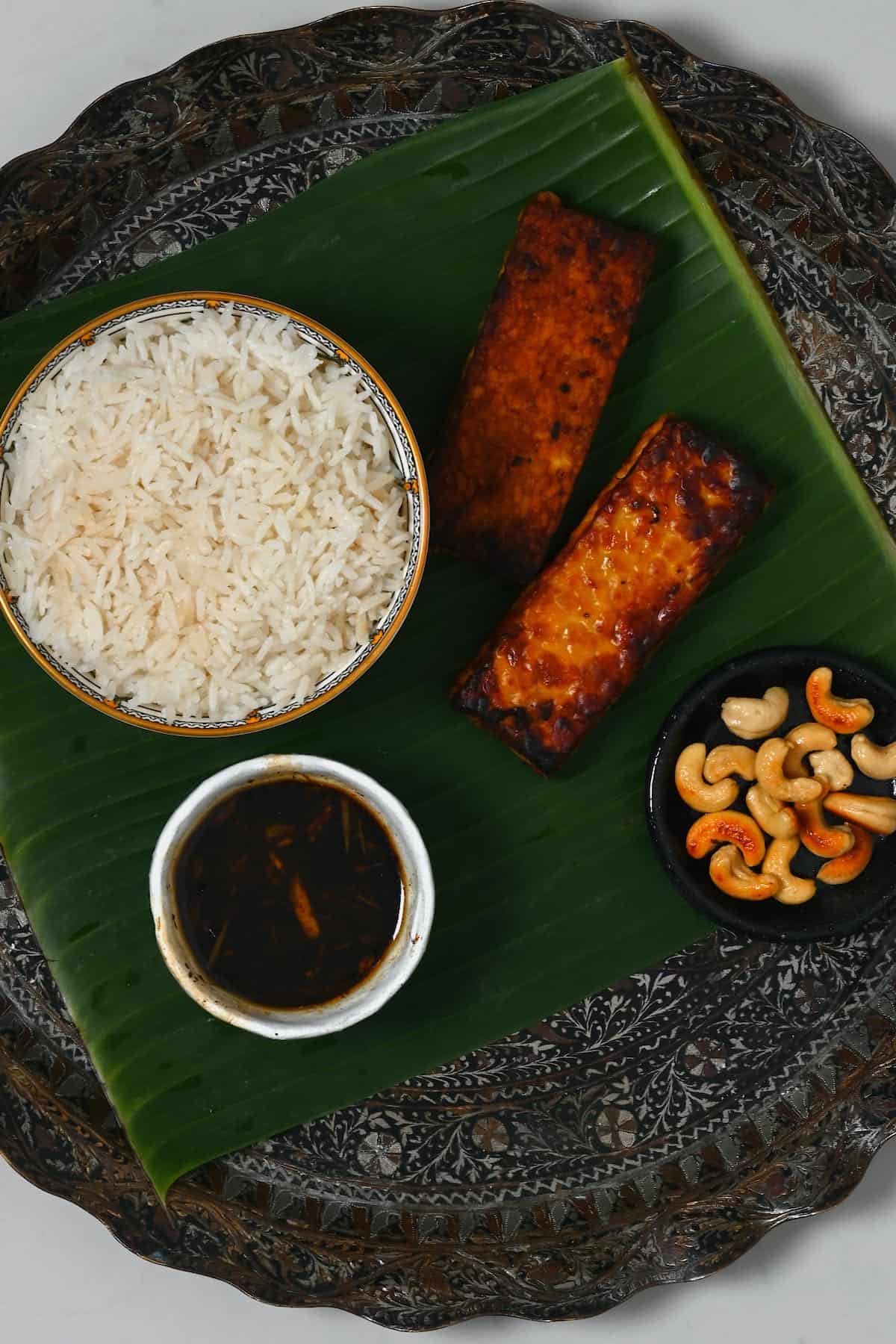
Recipe tips
- If you’re unable to find pandan leaves: you can omit them or use Indonesian bay leaf instead. It won’t taste the same but will help infuse the dish with extra flavor when pandan is unavailable.
- If you can’t find galangal: you could use galangal powder instead (around 1 Tbsp) or use a little extra ginger. It won’t be the same, but they have similar-ish flavors.
- Can I use an Instant Pot for cooking the coconut milk rice? Yes. This isn’t a method I’ve tried. However, a reader let me know they use the “rice” setting on their Instant Pot. Then allow it to steam for a further 10 minutes when ready before releasing the pressure completely.
More flavorful rice dishes
- Maqluba (Upside-down layered rice)
- Kimchi fried rice (Korean kimchi bokkeumbap)
- How To Make Cilantro Lime Rice (Coriander Rice)
- Breakfast fried rice with egg
- Easy coconut rice recipe
- Persian fluffy basmati dill rice
If you try this Indonesian nasi uduk recipe, I’d love to hear your thoughts/questions below. Also, I’d appreciate a recipe card rating below, and feel free to tag me in your recipe recreations on Instagram @Alphafoodie!

Simple Fragrant Indonesian Coconut Milk Rice (Nasi Uduk)
Ingredients
- 2 cups Jasmine rice or another long-grain rice like basmati
- 2.5 cups water or 2 cups if using rice cooker
- 1/2 cup coconut milk full-fat tinned
- 2 pandan leaves also called screwpine leaves; available fresh, frozen or dried in Asian stores
- 2 lemongrass stalks
- 0.14 oz ginger
- 0.14 oz galangal
- 1/8 tsp salt
Instructions
Step 1: Rinse the rice
- Rinse the rice well. To do this, place it into a sieve and then in a large bowl of water. Use your hands to rub the rice with your fingers until the water is milky white. Then discard that water and replace it with new water. Repeat this 3-4 times, or until the water is almost clear.
Step 2: Prepare the Aromatics
- Rinse the pandan leaves and tie them into knots. This will help them infuse their flavor into the rice more while cooking (and allows them to fit in the pot!).
- Lightly bash the lemongrass with the side of a large knife or a rolling pin/similar tool and tie them in a knot too.
Step 3: Cook the coconut milk rice
- Add all the ingredients to a saucepan and give the mixture a small stir and place its lid on.
- Bring the mixture to a boil over medium-high heat then lower to a simmer. Cook for 15-20 minutes. I recommend stirring it once after the first 5 minutes to reduce the risk of the coconut milk scorching at the bottom of the pan.
- Once you notice all the liquid has been absorbed, remove the pot from the heat and allow it to stand and "steam" for a further 10 minutes before removing the lid.You can also cook the nasi uduk in a rice cooker. Just be aware that you’ll need a little less water (check the recipe card for amounts). In a rice cooker, use the "white rice setting". Once ready, leave to steam for a further 10 minutes.
- Remove the lid and all the aromatics (knotted ingredients, ginger, and galangal). You can then serve it – typically, this is done as a "mound" or in a cone shape. Then enjoy with the mains and sides of your choice!
How to Store?
- Store: you can store the leftover rice in an airtight container in the refrigerator for between 3-4 days.Freeze: transfer the cooked rice to freezer-safe containers and freeze for up to 4 months. Allow to thaw in the fridge before reheating.Reheat: as rice sits, it tends to dry out. So when reheating, make sure to splash with a bit of additional coconut milk or water, then reheat on the stovetop, in the microwave, or on the "warm" function in your rice cooker.
Notes
- If you’re unable to find pandan leaves: you can omit them or use Indonesian bay leaf instead. It won’t taste the same but will help infuse the dish with extra flavor when pandan is unavailable.
- If you can’t find galangal: you could use galangal powder instead (around 1 Tbsp) or use a little extra ginger. It won’t be the same, but they have similar-ish flavors.
- Can I use an Instant Pot for cooking the coconut milk rice? Yes. This isn’t a method I’ve tried. However, a reader let me know they use the “rice” setting on their Instant Pot. Then allow it to steam for a further 10 minutes when ready before releasing the pressure completely.
- Indonesian bay leaf (daun salam): for even more flavor, you could add 3-4 Indonesian bay leaves to the mixture too. Alternatively, you could use curry leaves.
- Sugar: several versions of this Indonesian rice recipe include a pinch (or more) of sugar for a very subtle sweet aftertaste and flavor balance. I prefer it without but feel free to add a teaspoon or so to the recipe to experiment.
- Kaffir lime leaves: two kaffir lime leaves could also be added to the rice.
- Spices: cardamom, cinnamon, and cloves are all optional additions used in various restaurants and households. The amounts will vary to individual taste. I recommend adding the whole spices rather than ground (so you can pick them out afterward).
- Shallots: traditionally, nasi uduk is served topped with “bawang goreng”, which means fried shallots.
Nutrition
Nutrition information is automatically calculated, so should only be used as an approximation.















Made this for an adult family brunch and really enjoyed the whole experience. Went to an oriental supermarket in an area I don’t usually go to and managed to find all the ingredients. The instructions were great and never usually one to cook rice in a saucepan, I was pleased about how well it turned out. Tasted really yum and was a lovely part of our meal. I also made the tempeh which was the nicest tempeh I’ve ever had!! Served with cashews and steamed veg and scrambled egg and a store bought sambal .. as Aussie’s were close to Bali and this was almost as good as a weekend away
Thank you so much for your comment, Rachael. So happy you enjoyed the recipes!